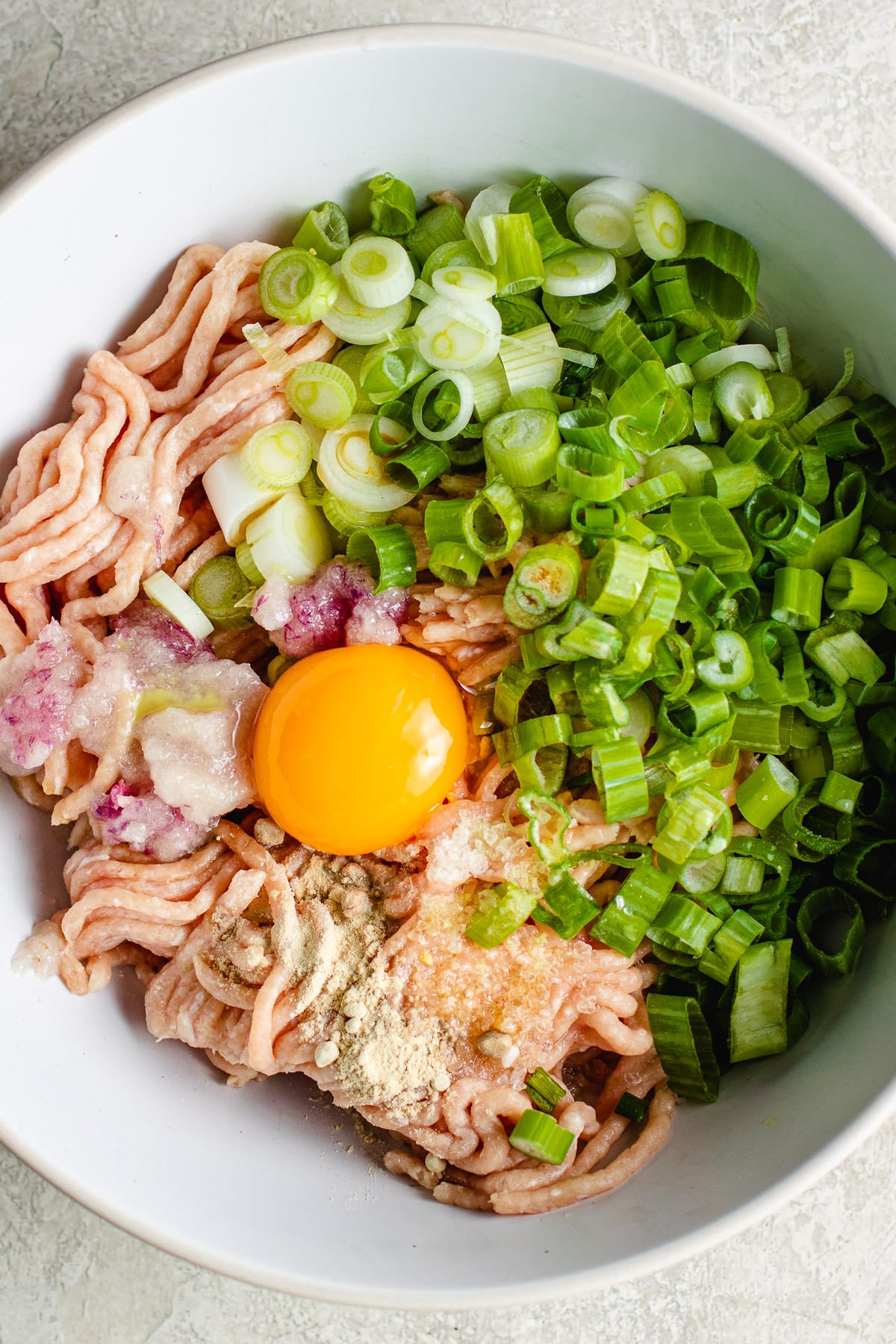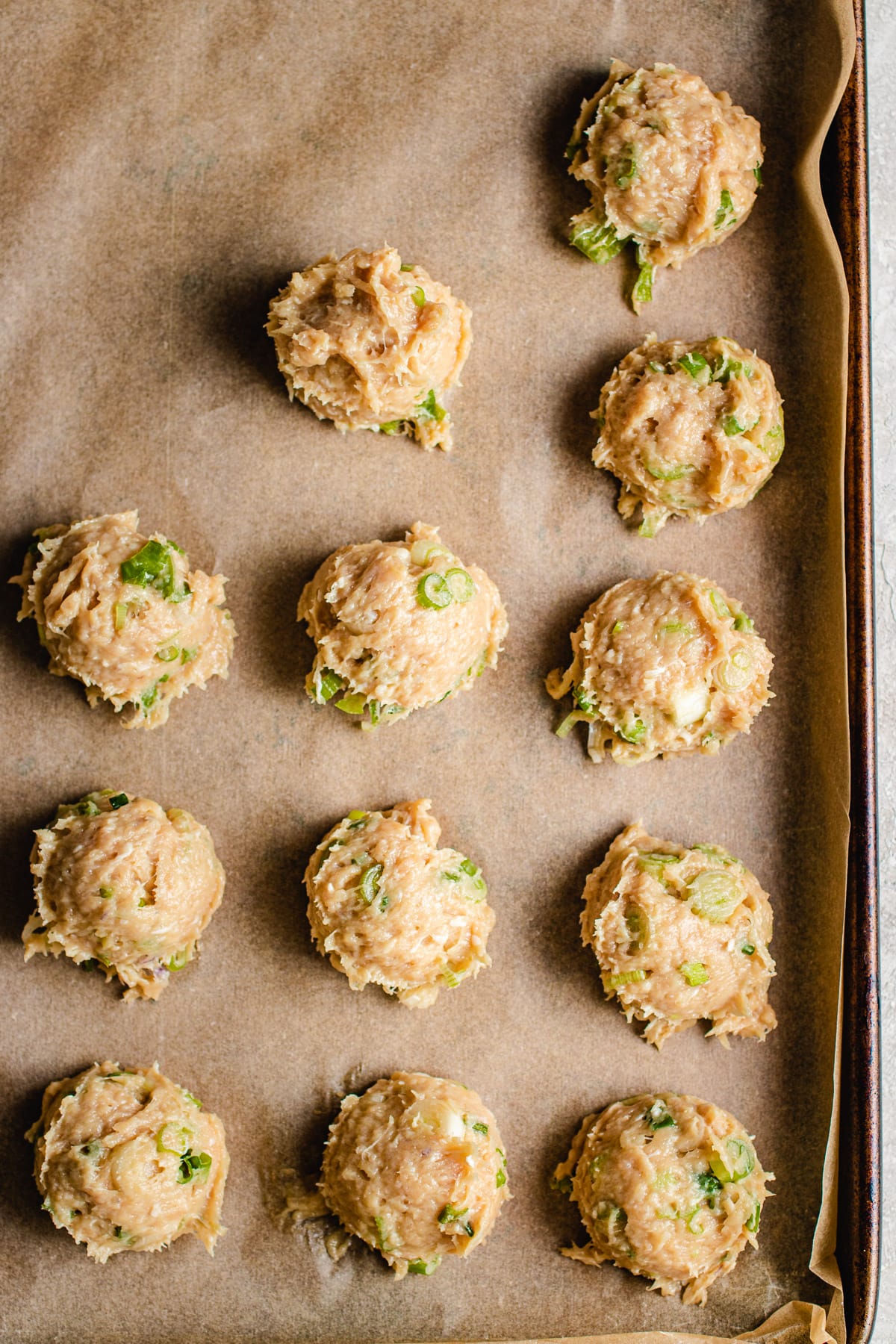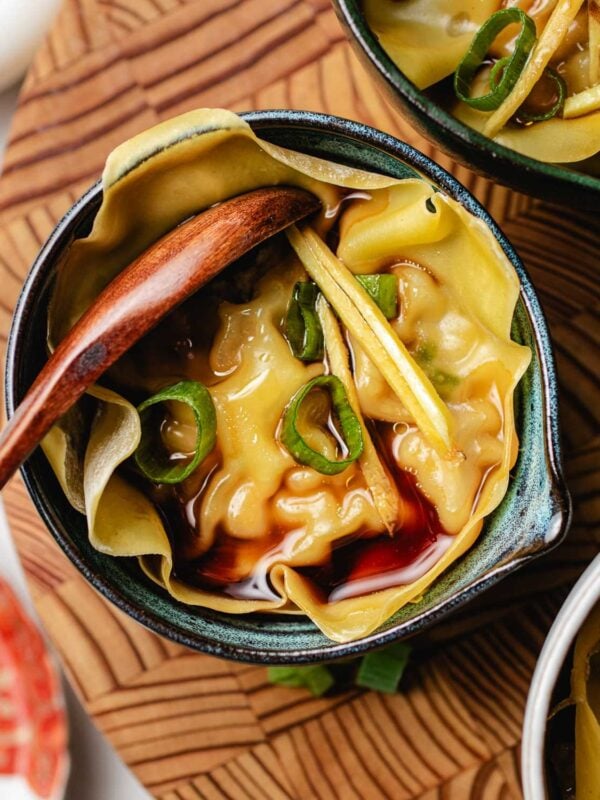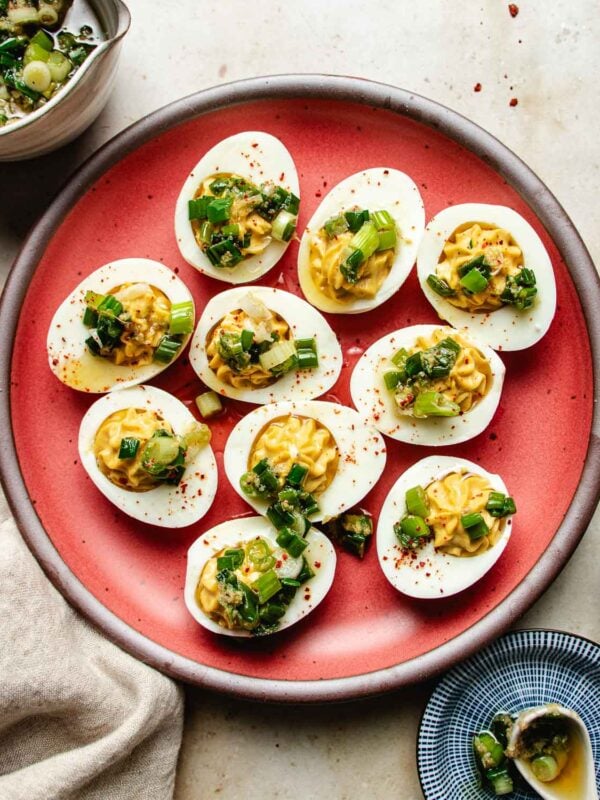This post may contain affiliate links. Please read our disclosure policy.
Tsukune, or Japanese chicken meatballs, are super fun to cook and even more delicious to eat. They’re soft, juicy, and coated in a tasty yakitori sauce, then cooked just right in a pan or on the grill. You’re going to love making them your new go-to recipe!
Looking for more fun recipes for summer grilling? You’ve got to try my Chicken Yakitori too. It’s a yummy Japanese chicken skewer dish that’s perfect for outdoor cooking!

Table of Contents
What is tsukune
Tsukune (つくね) are delicious Japanese-style meatballs that can be made from chicken, pork, or even fish, with the chicken version being the most beloved. These meatballs are known for their versatility, often grilled yakitori style on skewers over a charcoal fire, but they’re also great pan-fried or baked.
Yakitori Tare
What makes these Japanese meatballs so delicious is the secret sauce called Yakitori Tare. This sweet soy sauce blend combines soy sauce, mirin, sake, brown sugar, and water, creating a rich, salty-sweet flavor with incredible depth.
It’s similar to teriyaki sauce but thicker, making it perfect for basting and adding that special touch to the meatballs.
To keep things simple and healthy, I use my keto teriyaki sauce, which is perfect for anyone looking to enjoy these flavors without the added sugar.
Ingredients
Making Tsukune is much easier than you think! We use simple ingredients that pack a big flavor punch, so you can make these yummy meatballs at home with convenience.
- Ground chicken breast and thighs: The mix of breast and thigh meat ensures the meatballs are both lean and flavorful, providing a perfect balance of texture and juiciness.
- Toasted sesame oil: Adds a nutty, rich flavor that’s quintessential in Asian cooking, enhancing the overall taste profile of the meatballs.
- Scallions: These bring a mild, slightly sweet onion flavor that complements the chicken without overpowering the other ingredients.
- Coarse sea salt: Enhances the natural flavors of the meat and seasonings, also helping to bind the meatball mixture together.
- White pepper: Offers a subtle, earthy heat that differs from black pepper, contributing to the complex flavor profile of the dish.
- Coconut aminos: A soy sauce alternative that adds umami, a savory taste that deepens the flavor without adding gluten.
- Egg yolk: Acts as a binding agent, keeping the meatballs moist and together during cooking.
- Ginger juice: We use freshly grated and squeezed ginger. The juice flavor brightens the flavor and without the fibrous texture.
- Shallot: Adds a hint of sharpness and depth, enhancing the overall flavor complexity of the meatballs.
- Olive oil: Used for greasing hands and ensuring the meat doesn’t stick while forming the meatballs, also adds a mild flavor.
- Avocado oil: Has a high smoke point, making it ideal for pan-frying the meatballs without burning them, and contributes to their golden-brown exterior.
- Keto teriyaki sauce: This sauce adds a sweet, tangy glaze that coats the meatballs, offering a sticky, flavorful finish.
- Toasted sesame seeds (optional): Provides a crunchy texture and nutty taste that complements the soft, juicy meatballs beautifully.
- Butter lettuce: Serves as a fresh, crisp base or wrap for the meatballs, adding a refreshing crunch and visual appeal to the dish.
Substitutions and variations
Making Tsukune your own is easy with a few simple swaps or additions. Here’s how you can mix it up:
- Mix it up: Combine ground chicken with ground pork to up the fat content for juicier meatballs.
- Whole30 friendly: Swap in my Paleo teriyaki sauce to keep it compliant with your eating plan.
- Add some heat: Fancy a bit of spice? Sprinkle some Japanese chili powder (Shichimi togarashi) over the meatballs when serving.
- Extra flavors: Enhance your Tsukune with a sprinkle of toasted sesame seeds, furikake, or any seaweed sprinkles for an extra burst of taste and texture.
How to make Tsukune
I use ginger juice (from grated ginger) and grated shallot to make my meatballs extra flavorful, ensuring each bite is bursting with taste. Follow these simple steps to bring this savory Japanese favorite to your table.
- Prepare the Sauce: Simmer the keto teriyaki sauce first with coconut aminos or soy sauce, sweetener, garlic, ginger, and a touch of vinegar and starch. Let it thicken, then set it aside to cool.

- Mix the Meat: In a big bowl, combine ground chicken, sesame oil, scallions, salt, white pepper, coconut aminos, and egg yolk. Grate ginger, squeeze out 1 tbsp of juice, grate the shallot, and mix both into the bowl. Stir everything in one direction with chopsticks (or a stand mixer) until it’s sticky and smooth, about 2 minutes.

- Shape the Meatballs: Line a tray with parchment paper. Use a cookie scoop to measure out the meat, forming about 13 meatballs. Oil your hands with olive oil, then shape the meatballs until smooth.
- Cooking Options:
- Pan-Fry: Flatten meatballs into patties. Cook in avocado oil over medium heat. Start with 2.5 minutes on one side, flip, brush with sauce, and continue cooking, flipping, and brushing with sauce, for 1.5 minutes on each side.
- Grill: Flatten and skewer the meatballs (if using skewers), or place them directly on a greased grill tray. Grill each side for a few minutes, brushing with teriyaki sauce as you turn them.
- Serve Hot: Finish with a brush of teriyaki sauce, and a sprinkle of sesame seeds, and serve over butter lettuce. Enjoy your sizzling Tsukune straight from the grill or pan!
Tips:
- Stir the meat mixture in one direction until it’s smooth and sticky for meatballs that hold together well.
- Test fry a small piece to adjust seasonings if necessary.
- The meatball mixture can be prepped ahead and stored in the fridge for 24 hours before cooking.
Tips for soft, smooth, juicy chicken meatballs
Creating the perfect Japanese meat skewers is all about balance and technique. Here are some key tips to ensure your meatballs are as soft, smooth, and juicy as they can be:
- Add Some Fat: Since chicken is leaner than pork or beef, adding a bit of fat is crucial. Mix 50% ground chicken breast with 50% ground chicken thighs, or blend in some ground pork, to boost the fat content for juicier meatballs.
- Egg Yolk Magic: Incorporating a whole egg yolk into your mixture introduces more good fats, helping your meatballs stay moist throughout the cooking process.
- Flavor Boosters: Use ginger juice (squeezed from freshly grated ginger) and grated shallot. These ingredients not only enhance taste but also contribute to the soft texture of the meatballs.
- Mixing Technique: Stir the meat mixture in one direction until it turns into a smooth and very sticky paste, much like the process for making beef wonton. This method helps bind the ingredients tightly together, ensuring your meatballs hold their shape and retain moisture.
Help, my meatballs are falling apart!
Don’t worry if your Japanese meatballs seem a bit too eager to fall apart; there’s always a fix to keep them together and still delicious. Here’s what you can do:
- Breadcrumbs to the Rescue: If your ground chicken feels too watery and you’re struggling to shape your meatballs, a sprinkle of breadcrumbs or panko can save the day.
- Aim for about ¼ to ⅓ cups of panko or breadcrumbs per pound of meat to help bind everything together without losing the meatballs’ tenderness.
- Patience Pays Off: While cooking, let one side of the meatballs brown well before flipping them. This not only helps in keeping them intact but also gives you that perfect crust.
- Grilling Made Easy: If you’re grilling, a perforated grilling tray is your best friend. It allows you to cook the meatballs directly on the grill without the need for skewers.
- Shape Matters: Slightly flattening the meatballs can make a big difference. It ensures even cooking throughout, especially through the center, making them easier to handle.
- Size Does Count: Consider making smaller meatballs, about 1 inch in size. They’re easier to shape, cook, and keep together, plus they make for delightful bite-sized treats.
How to make ahead, store, and reheat
Getting a head start on your chicken tsukune is a breeze and a great way to save time. Here’s how to make them ahead, store them, and reheat them for a delicious meal anytime.
- Make-ahead: You can prepare the meatballs and keep them in the fridge for up to 24 hours before you need them. The sauce, too, can be made well in advance – up to 4-5 days ahead – and stored until it’s time to cook.
- Storage: After cooking, place your Tsukune in an airtight container and refrigerate. They’ll stay fresh and tasty for up to 4 days.
- Reheat: When you’re ready to enjoy your meatballs again, just pop them in the microwave on medium for about 1 minute, or until they’re warmed through.
How to eat and what to serve with Japanese chicken meatballs
These flavorful grilled chicken meatballs are versatile enough to be the star of any meal. Here’s a guide to pairing them with a variety of dishes, organized into four delicious categories:
- Izakaya Style: For an authentic izakaya experience, try dipping your Tsukune in raw egg yolk mixed with a dash of sweet soy sauce. This combination enhances the meatballs’ flavor and adds a luxurious texture.
- Refreshing Side Dishes: Complement your Tsukune with light and refreshing sides like Japanese potato salad, Japanese spinach salad, Silken tofu with roasted sesame dressing, or Japanese cucumber salad. These sides add a crisp, clean contrast to the savory meatballs.
- Low Carb Options: If you’re watching your carb intake, pair Japanese bbq meatballs with butter lettuce for a wrap, Omurice (Japanese omelette rice) for a satisfying meal, Nori sushi wraps for a touch of the sea, Shirataki noodles with peanut sauce for a nutty twist, or Tuna Temaki for a handheld delight.
- Drinks: No meal is complete without the perfect drink. Sake grapefruit cocktail and Iced matcha mango tea are refreshing choices that cleanse the palate and round off the meal beautifully.
Tips for success
- Fat is Flavor: Remember, the right mix of chicken thigh (dark meat) and breast (white meat or a bit of ground pork) is crucial for juicy, flavorful meatballs. Don’t shy away from a little fat!
- Ginger Juice Trick: For a deep, vibrant flavor without fibrous bits, use a small amount of ginger juice instead of grated ginger. It’s the secret to a smooth texture and a burst of freshness.
- Mixing Matters: Stir your meat mixture in one direction until it becomes very sticky. This technique helps the meatballs hold together and stay juicy after cooking.
- Shape Wisely: If your meatballs are falling apart, don’t forget the breadcrumbs or panko breadcrumbs hack. And slightly flatten them for even cooking.
- Cooking Method: Whether you’re grilling or pan-frying, ensure your meatballs are browned on one side before flipping. This seals in the juices and gives them a nice crust.
- Sauce Savvy: Making the teriyaki sauce ahead of time not only saves you effort on the day of cooking but also allows the flavors to meld together beautifully.
FAQs
Enjoy skewered meatballs with refreshing sides like Japanese potato salad, spinach salad, or cucumber salad. Low-carb options include butter lettuce wraps and shirataki noodles. Pair with sake or iced matcha for drinks.
Tsukune is traditionally made from ground chicken, blending both breast and thigh meat for a juicy and flavorful meatball. However, it can also include pork or fish for variation.
Yes, you can bake Tsukune by broiling them for 8 to 10 minutes, flipping every 2 minutes, until they reach an internal temperature of 165°F (74°C) for a safe and delicious result.
More Asain BBQ recipes you might like
If you love making Japanese chicken meatballs, we’ve got more mouthwatering dishes that’ll pique your interest and keep those taste buds happy.
- Marinated Beef Kabobs with Broccoli: Juicy, marinated beef paired with crisp broccoli on skewers, perfect for grilling and packed with flavors.
- Vietnamese Grilled Chicken Drumsticks: These drumsticks are marinated in a blend of Vietnamese spices and grilled to perfection, offering a delightful balance of sweet and savory.
- Kalbi (Korean Short Ribs): Marinated in a sweet and savory sauce, these grilled ribs are tender, flavorful, and a staple in Korean cuisine.
- Grilled Peach Avocado Salad: A refreshing combination of sweet grilled peaches and creamy avocado, this salad is a perfect side dish for any summertime meal.

Tsukune recipe (Japanese Chicken Meatballs)

Video
Ingredients
For the Tsukune meatballs:
- 1 lb ground chicken breast and thighs 50% breast; 50% thighs
- 1 tsp toasted sesame oil
- 2 bulbs scallions chopped
- ½ tsp coarse sea salt
- ¼ tsp white pepper
- 1 tbsp coconut aminos
- 1 large egg yolk
- 0.5 oz ginger grated and squeezed into 1 tbsp ginger juice
- 0.8 oz shallot grated
- 1-2 tbsp olive oil
- 1 tbsp avocado oil
For the sauce and serving:
- 1/4 cup Keto teriyaki sauce plus some extra for serving
- Toasted sesame seeds optional
- 1 head butter lettuce
Equipment
- Flat skewers
- Perforated grill tray or grill grid
Instructions
Make the sauce:
- Make the keto teriyaki sauce. Set it aside to cool.
Make the meatballs:
- In a large mixing bowl, add ingredients from chicken to egg yolk.
- Grate the ginger and squeeze it into juice. You should have about 1 tbsp of ginger juice. Grate the shallot and add both the ginger juice and grated shallot into the meat mixture.
- Stir the meat mixture (I use a pair of chopsticks) in one direction until it becomes very sticky, soft, and smooth, about 2 minutes. If you have a stand mixer, use it to help you bind the meat together.
- Line a large sheet pan with parchment. Utilize a cookie scoop to weight the meatballs, allocating approximately 3 tablespoons of mixture for each meatball. This process should yield a total of 13 meatballs.
- Grease your hands with some olive oil. This will prevent the meat from sticking to your hands. Shape the meatballs into a smooth surface.
- Before cooking, you can fry up a small piece to see if you need to adjust the seasonings.
If pan-fry (easiest way):
- Flatten the meatballs into small patties (about ½-inch thick). Pan fry them with avocado oil over medium heat about 2.5 minutes on the first side. Flip the patties and brush with teriyaki sauce. Fry the second side for about 1.5 minutes. Flip the patties again, brush with more sauce, and fry 1.5 minutes more.
If grill:
- Use a narrow flat skewer with a handle at one end and a perforated grill tray or grill grid on top of your grill surface to support the skewers or they will fall apart.
- Flatten the meatballs into small patties (about ½-inch thick) and thread them onto the skewers. Brush the grill tray with avocado oil. Cradle the entire skewer in your hand to keep the meat on the stick and place it on the grill grid.
- Grill the first side about 3-4 minutes, rotate to grill the second side about 2-3 minutes, and rotate again to grill for 15-30 seconds longer. Brush with the teriyaki sauce as you rotate the skewers.
To serve:
- Brush with a thin layer of teriyaki sauce, sprinkle with sesame seeds, and serve over butter lettuce. Enjoy it while they are sizzling hot!
Notes
- Knead the chicken mixture until it becomes very smooth and sticky so the meatballs are less likely to fall apart.
- The meatballs can be made up to 24 hours ahead in the fridge.
- Grate the ginger and squeeze the ginger juice into the meat mixture.
- Use some muscle to grate the shallot. The meatballs will be extra flavorful and juicy.
- When grilling, use narrow flat skewers and a perforated grilling tray to support the skewers from falling apart.
- You can also not skewer the meatballs, just grill them directly on a perforated grill tray on top of the grill.
- Baste the chicken meatballs as you flip and cook each time so they are very well seasoned on all sides.
- If on Whole30, try my Whole30 Teriyaki sauce. The sauce will taste less sweet than the keto version.
Nutrition
Nutrition information is automatically calculated, so should only be used as an approximation.













I only made the patties and not the sauce, but they are delicious! really nice balance of flavor.
I did use the stand mixer and wonder how that affects the texture of the meat? I’ve seen the stand mixer used in other asian meatball recipes.
anyway, I will definately be making these again! Thank you for the recipe and I will be trying more!
So happy to hear, thank you, Chris!